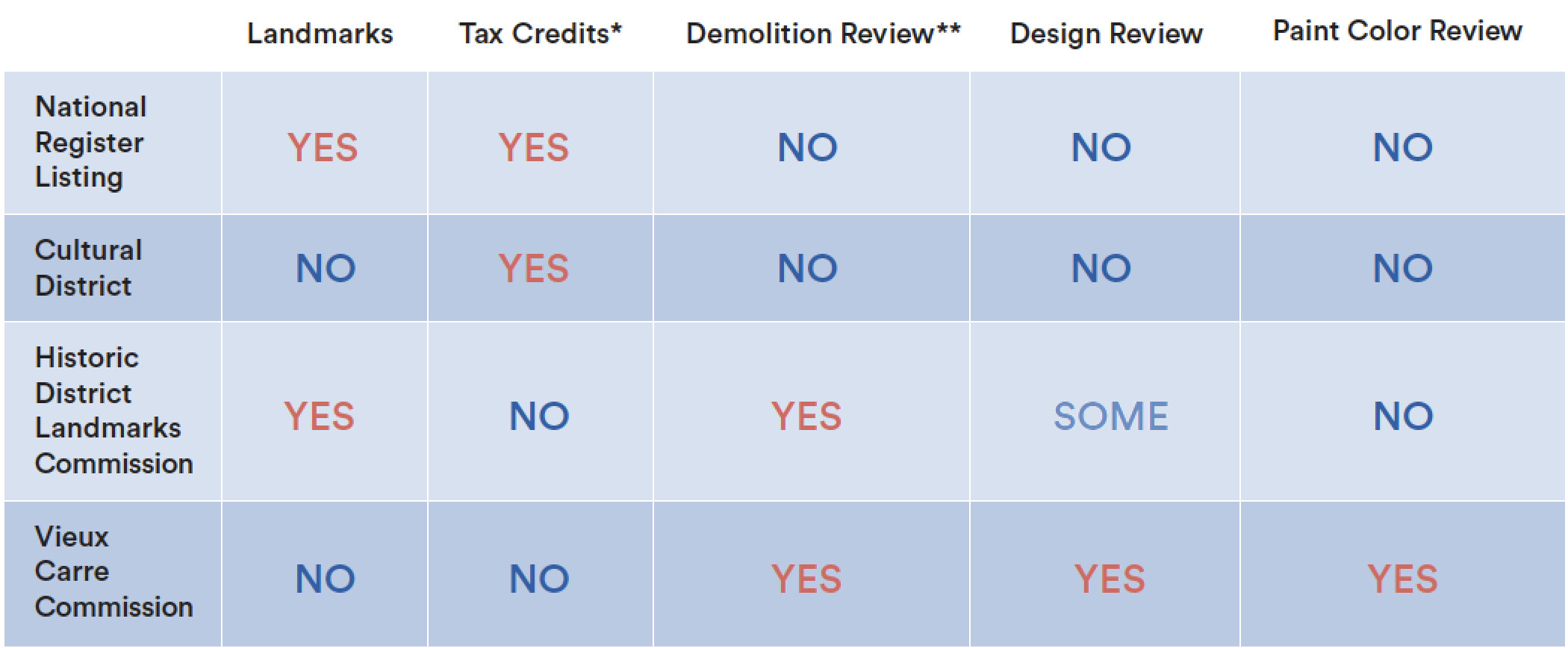This story appeared in the September issue of PRC’s Preservation in Print magazine. Interested in getting more preservation stories like this delivered to your door nine times a year? Become a member of the PRC for a subscription!
New Orleans’ three-century-long history and rich culture are reflected in its architectural diversity: Creole townhouses, bracketed shotguns, mid-century modern homes and more. Efforts to document and protect the city’s architectural legacy also come in many forms. This can lead to confusion about what a historic designation means for property owners and residents. Whether you live or work in an existing historic district, are considering relocating to one, or want to gain recognition for your neighborhood, it’s important to understand the various designations found in New Orleans.
The National Register of Historic Places
Maintained by the National Park Service, the National Register lists individual buildings, sites and structures, as well as collections of historic resources known as districts. To be included, a place must be found significant to the history of a community, state or the nation. That significance can be based on an association with historical events or people, architectural or engineering merit, or the presence of archeological resources. National landmarks can be thought of as the upper echelon of these places, representing less than three percent of the 95,000 National Register listings.
The St. Charles Avenue Streetcar Line and Gallier Hall are two of 26 National Historic Landmarks in New Orleans. There are also 26 National Register Historic Districts covering thousands of structures; one of the smallest includes nine buildings at Dillard University, while the largest encompases 750 blocks of Uptown. Anyone may propose a property or a district for the National Register, but those submitting a nomination must follow the process set by the National Park Service and Louisiana Division of Historic Preservation.
Benefits
A listing on the National Register of Historic Places is honorific in nature. It also may make property owners of commercial or residential rental units “eligible to apply for and receive federal tax credits for historic rehabilitation projects, provided they agree to certain federal guidelines,” according to the Louisiana Office of Cultural Development’s Division of Historic Preservation. A National Register listing also triggers heightened scrutiny of federal projects that might negatively affect historic places, such as a roadway planned through a historic district. That process is called Section 106.
Does it restrict property owners?
No. A National Register designation does not restrict owners’ rights to use or alter their properties in any way, including demolition.
Click here to learn more.

Gallier Hall and the St. Charles Avenue Streetcar Line are two of 26 National Historic Landmarks in New Orleans.
Louisiana Cultural Districts
A state designation created by the Louisiana Legislature in 2007, cultural districts are administered by the Office of Cultural Development, Division of the Arts. The program’s primary goal is to support community revitalization based on cultural activity, such as music or food festivals, art walks and culture-based tourism. In some jurisdictions, cultural districts are primarily managed by local government staff; in New Orleans, volunteers representing businesses or community organizations help to manage cultural districts.
As of July 2020, Louisiana had 106 cultural districts, including 24 in New Orleans. The state reviews proposals for new cultural districts annually, and each must include a resolution of support from the local government.
Benefits
Cultural districts may make properties eligible for Louisiana’s state historic rehabilitation tax credit, which provides owners or developers 20 percent back on qualifying costs for commercial renovations of historic structures. These credits are available only in cultural districts and downtown development districts. Additionally, original artwork, such as paintings and sculpture, sold in a cultural district is exempt from local sales tax.
Does it restrict property owners?
No. A cultural district designation does not restrict owners’ rights to use or alter their properties in any way, including demolition.
Click here to learn more.
Local Historic Districts and Landmarks
Only local historic districts impose restrictions on the design, alteration or demolition of buildings. In New Orleans, local districts are overseen by three appointed commissions: The New Orleans Historic District Landmarks Commission, the Central Business District Historic District Landmarks Commission and the Vieux Carré Commission.
Local historic districts. Map via nola.gov/hdlc
The New Orleans Historic District Landmarks Commission (HDLC)
The New Orleans Historic District Landmarks Commission (HDLC) regulates 14 districts, which include both “full control” areas, where the commission must approve new construction and all exterior work to a building visible from the right of way, and “partial control” areas, where its oversight is limited to demolition and some building requirements. Rules vary by neighborhood. The New Orleans HDLC shares a staff with the Central Business District HDLC, which must approve demolition, renovation and construction in four historic districts downtown. HDLC districts are set by New Orleans City Council ordinance. Local laws also authorize HDLC commissioners to designate individual landmarks, provided the properties are privately owned; commissioners are limited to an advisory role in matters involving government property. Property owners who dispute an HDLC decision may appeal to the City Council. The list of HDLC districts and information on the levels of regulation can be found at nola.gov/hdlc.
Does it restrict property owners?
Yes. The HDLC regulates the exterior of properties in certain historic districts within the city. Homeowners wishing to alter their property may need to get prior approval from the HDLC, depending on their district’s level of regulation. Property owners also can be cited for the condition of their property with “demolition by neglect” citations.
Does it provide tax incentives?
No. HDLC oversight does not provide access to state or federal incentives.
The Vieux Carré Commission (VCC)
The Vieux Carré Commission (VCC) oversees buildings in the French Quarter. One of the oldest preservation commissions in the nation, the VCC has jurisdiction in an area determined by state law. VCC regulations are the strictest in the city and govern “anything the air touches,” including areas not visible from the street, such as courtyards. Exterior paint colors must be approved prior to painting a building. A full list of regulations can be found at nola.gov/vcc.
Does it restrict property owners?
Yes. The VCC regulates all exterior parts of a property in the French Quarter. All work must be pre-approved by the VCC.
Does it provide tax incentives?
No. VCC oversight does not provide access to state or federal incentives.

*An individual’s primary residence is generally not eligible for historic tax credits; however an income-producing unit, such as the rented half of a double shotgun, may qualify. In order to qualify, a property owner must receive design approval for both interior and exterior changes.
**Demolition of property not under HDLC or VCC jurisdiction still requires a permit.
Nathan Lott is the policy research director and advocacy coordinator for the Preservation Resource Center of New Orleans.








